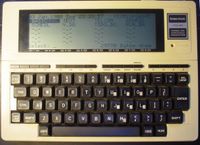From the start Viditel did not appear the magnet for all information services. The videotex technology with its 40 characters on a line, 24 lins per page and branching structure did not accommodate professional databases well. So the database providers sought for solutions in ASCII services with 80 chracter per line, and scrolling screens. Besides the PC made its entry in the business sector, stand alone and portables (sometimes luggables of 5 or more kilos).

My first portable Tandy Model 100. It had internal memory of 40K, the operating system was Basic of Microsoft and it had a modem of 300 bps on board; it was very light; it is still working, be it that the time did not pass the millenium test (collection Jak Boumans)
While Kluwer was canvassing the lawyers, a service was started up for the world of construction and town planning. In 1982 the Rotterdam company Building & Town Planning started with the development of its own databases, bought third party databases and offered timesharing. However the company appeared to be too optimistic about its target group and folded in 1985. It was the first privately held company.
The publisher Samsom – these days part of Wolters Kluwer – made a serious attempt to become a private host in the Netherlands with Samsom Data Systems (SDS). Samsom was much in computer activities and had a computer bureau. With capacity available on its IBM mainframes SDS launched its services in August 1981. Besides Dutch databases like Marna of the Marine Information Center and Tropag of the Royal Tropical Institute, a lot of uncorrelated databases such as the library database Lisa and Mathfile were mounted. At the start some 50 access codes had been given out; by autumn 1982 there were 200 access codes in circulation. Given the expenses of 1 million Dutch guilders (450.000 euro), 100.000 connected hours or 500 users were needed. This objective was not reached, so the service was suspended in December 1983.
The government computer center RCC, did also an attempt to develop a host service. As the service was involved in the development of many government databases, selected databases, often library databases, were also made available for the public. In 1999 RCC had 25 public databases with 1 million documents. In 1991 RCC acquired the information service Marketing Data and expressed the ambition to become the ASCII host for the Netherlands. But this ambition was never realised as in 1994 a disinvestment program was set in by the new owner Roccade.
In 1986 The Hague proclaimed itself as the Telematica city of the Netherlands. One of the initiatives of the program was the start of a press database to retrieve and consult press releases and published articles. The Dutch wire service offered its ANP news database and other publishers forwarded their data. In 1990 the quality paper NRC Handelsblad started its online archive with the Press database. Other publishers followed suit. (The publishers that offered the databases did not have any notion about the copyright of their journalists and contributors. Only after some court cases their obligations became clear after 2000). The Press database eventually became part of the LexisNexis databases.

(Collection Jak Boumans)
According to my Online Handboek (Spectrum, 1986) there were 50 ASCII databases produced and commercially available in the Netherlands. Some 75 databases, produced by 54 database producers were going to come on stream due to a grants program. Just before the switch to Internet in 1992 some 180 ASCII databases were available; most of them made a seamless transfer to Internet.

No comments:
Post a Comment